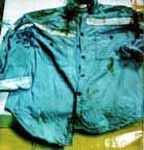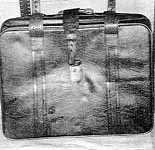http://www.dailylocal.com/article/DL/20110918/NEWS/309189998
NEWS
A murder case that won't die
A reconstruction of the victim's facial features.
By JENNIFER CARBONI
jcarboni@dailylocal.com">
jcarboni@dailylocal.com
POSTED: 09/18/11, 12:01 AM EDT
A woman is dead, but an obituary has not been printed, a memorial service has not been held, a eulogy has not been offered by a loved one, a casket has not been lowered into the ground before a grieving family, and a headstone has never been engraved.
And that's because authorities have been unable to identify the homicide victim.
For the last 16 years this woman has not had a real name. Instead, she is known as "Jane Doe 1995" and as U-853071055 in the federal computerized database for missing or unidentified people, the National Criminal Information Center (NCIC).
This anonymous woman became part of a local criminal investigation July 11, 1995, when state police responded to East Caln along the Brandywine Creek for the report of a horrific discovery: female body parts were found inside a suitcase.
Inside the leather, maroon suitcase, state police found a woman's upper body. Her torso was wrapped in a sheet and then placed inside a plastic quilt bag. The bag was then wrapped in a quilt, placed in the suitcase, which was then bound with wire, taped and placed in the green garbage bag, according to details released by authorities.
Chester County Common Pleas Judge Anthony Sarcione, who was the county's district attorney when the Jane Doe mystery unfolded, said the case still disturbs him. Each time he drives by Brandywine Creek where a fisherman found the green garbage bag, he said he can't help but think of the gruesome discovery.
"I remember that case very well. It haunts me regularly...It was a grisly discovery once we opened the suitcase. These things are forever embedded in my mind," Sarcione said. "That case was one of the most haunting cases I dealt with as DA. I can't just put some of those images I saw there out of my mind...It was one of the most gruesome scenes I've had to view in my career of over 25 years in law enforcement."
Jane Doe reportedly had a bruised right eye and two small bruises on her back. No evidence indicated she was strangled or raped, officials said. Jane Doe also reportedly had a low blood-alcohol content showing she had roughly one or two drinks before her death.
Women's clothing found inside the suitcase included a light-blue denim shirt with a collar, long sleeves, copper-colored buttons and light-colored bands across the chest and back as well as a denim skirt and other clothing.
Investigators immediately faced roadblocks. There was nothing inside the suitcase to identify the victim, such as a driver's license. She did not have any tattoos, scars or other distinguishing marks and her fingerprints did not match any records in law enforcement databases.
The little details police could release to the public -- in hopes of someone identifying the victim -- included physical descriptions. Officials determined Jane Doe had brown hair, brown eyes, a light complexion and pierced ears. She was possibly Eastern European or Hispanic. She was between 4 feet 11 inches and 5 feet 3 inches tall and weighed between 120 and 140 pounds.
The age of the victim remains unclear. Experts said she could have been as young as 17 or as old as 30 or 40 at the time of her death. Authorities also determined she had been dead for less than a week.
Cpl. Patrick Quigley was one of the case's original investigators. Most recently, he has worked out of the Avondale state police station as the criminal investigative assessment officer for Chester and Lancaster counties. The position handles violent crimes, crime scene investigations and cold cases.
The Jane Doe case has been particularly frustrating for Quigley.
"These are cases that bother us because we can't even begin to investigate why they're dead until we figure out who they are," Quigley said.
Roughly seven months after police discovered the suitcase, partially skeleton legs were found wrapped in trash bags in the Cores Creek State Park in Middleton, Bucks County. Clothing was also found inside the bag, including women's formal attire, women's casual attire and girls' casual apparel.
While authorities believe the legs belong to Jane Doe, the assumption could not be confirmed through DNA due to decomposition, Quigley said. In 1996, DNA testing was not advanced enough to make a positive link therefore ultimately Bucks County officials cremated the legs, which at the time was routine due to limited storage space. Investigators were never able to link the torso and legs by DNA.
Quigley said he understands why Bucks County officials destroyed the remains. He also said today investigators recognize that technology advances rapidly and DNA capabilities are continually advancing. Now, Quigley said, such evidence is retained with the hope that future technology will help solve a case.
"You don't know the way technology is going to develop 25 years down the road," Quigley said.
Chester County investigators have made several efforts to solve the Jane Doe homicide. Her fingerprints were added to a national law database, the Automated Fingerprint Identification System as well as an international police database, INTERPOL. Her DNA was also added to into a national database called CODIS (Combined DNA Index System).
The CODIS system cross checks DNA with violent convicts. It's possible an anonymous victim could be the relative of a violent convict. Such a link would help authorities identify Jane Doe and possibly her killer. Yet finding such a match only has a 5 to 10 percent success rate, Quigley said.
"It's like a needle in the haystack," he said.
At the same time, 15 years ago, there was no possibility of finding a match through such a system.
Making the case more challenging, if Jane Doe was an adult at the time of her death it's possible she left home one day and no one reported her missing, Quigley said.
"Adults have a right to disappear ... people walk away all of the time without it being suspicious," he said. "We're working against people who just walked away, people who have no family, no one missing them, no one to report them missing. We work against the people not reporting someone missing because there's no reason to report them missing. That's frustrating."
Among the many efforts made to solve this crime, the National Center for Missing & Exploited Children, a non-profit with a team of retired law enforcement experts and a cold case unit, has assisted with the Jane Doe investigation because it is possible Jane Doe was a juvenile when she died. Specifically, the organization helped create a clay reconstruction of Jane Doe's face in hopes someone in the public would recognize her. County investigators also released a computer generated facial reconstruction, which was sent to the Mexican Consulate in Philadelphia in case she was a Mexican national.



























